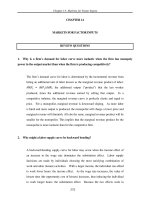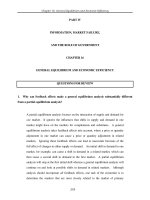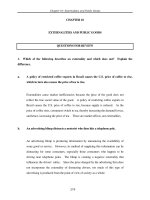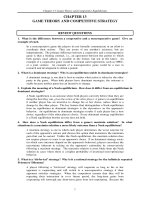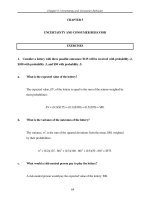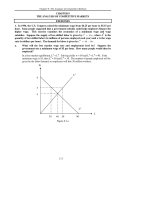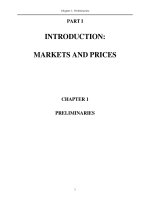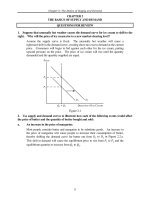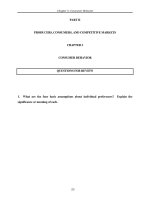Tài liệu Câu hỏi đánh giá môn Kinh tế vĩ mô bằng tiếng Anh- Chương 5 pptx
Bạn đang xem bản rút gọn của tài liệu. Xem và tải ngay bản đầy đủ của tài liệu tại đây (55.64 KB, 5 trang )
Chapter 5: Uncertainty and Consumer Behavior
64
CHAPTER 5
UNCERTAINTY AND CONSUMER BEHAVIOR
QUESTIONS FOR REVIEW
1. What does it mean to say that a person is risk averse? Why are some people
likely to be risk averse, while others are risk lovers?
A risk-averse person has a diminishing marginal utility of income and prefers
a certain income to a gamble with the same expected income. A risk lover
has an increasing marginal utility of income and prefers an uncertain income
to a certain income. The economic explanation of whether an individual is
risk averse or risk loving depends on the shape of the individual’s utility
function for wealth. Also, a person’s risk aversion (or risk loving) depends
on the nature of the risk involved and on the person’s income.
2. Why is the variance a better measure of variability than the range?
Range is the difference between the highest possible outcome and the lowest
possible outcome. Range does not indicate the probabilities of observing
these high or low outcomes. Variance weighs the difference of each
outcome from the mean outcome by its probability and, thus, is a more useful
measure of variability than the range.
Chapter 5: Uncertainty and Consumer Behavior
65
3. George has $5,000 to invest in a mutual fund. The expected return on mutual
fund A is 15% and the expected return on mutual fund B is 10%. Should George
pick mutual fund A or fund B?
George’s decision will depend not only on the expected return for each fund,
but also on the variability in the expected return on each fund, and on
George’s preferences. For example, if fund A has a higher standard
deviation than fund B, and George is risk averse, then he may prefer fund B
even though it has a lower expected return. If George is not particularly risk
averse he may choose fund A even if it subject to more variability in its
expected return.
4. What does it mean for consumers to maximize expected utility? Can you think
of a case where a person might not maximize expected utility?
The expected utility is the sum of the utilities associated with all possible
outcomes, weighted by the probability that each outcome will occur. To
maximize expected utility means that the individual chooses the option that
yields the highest average utility, where average utility is a probability-
weighted sum of all utilities. This theory requires that the consumer knows
the probability of every outcome. At times, consumers either do not know
the relevant probabilities or have difficulty in evaluating low-probability,
high-payoff events. In some cases, consumers cannot assign a utility level
to these high-payoff events, such as when the payoff is the loss of the
consumer’s life.
Chapter 5: Uncertainty and Consumer Behavior
66
5. Why do people often want to insure fully against uncertain situations even when
the premium paid exceeds the expected value of the loss being insured against?
If the cost of insurance is equal to the expected loss, (i.e., if the insurance is
actuarially fair), risk-averse individuals will fully insure against monetary
loss. The insurance premium assures the individual of having the same
income regardless of whether or not a loss occurs. Because the insurance is
actuarially fair, this certain income is equal to the expected income if the
individual takes the risky option of not purchasing insurance. This guarantee
of the same income, whatever the outcome, generates more utility for a risk-
averse person than the average utility of a high income when there was no
loss and the utility of a low income with a loss (i.e., because of risk aversion,
E[U(x)] ≤ U(E[x]).
6. Why is an insurance company likely to behave as if it is risk neutral even if its
managers are risk-averse individuals?
Most large companies have opportunities for diversifying risk. Managers
acting for the owners of a company choose a portfolio of independent,
profitable projects at different levels of risk. Of course, shareholders may
diversify their risk by investing in several projects in the same way that the
insurance company itself diversifies risk by insuring many people. By
operating on a sufficiently large scale, insurance companies can assure
themselves that over many outcomes the total premiums paid to the company
will be equal to the total amount of money paid out to compensate the losses
of the insured. Thus, the insurance company behaves as if it is risk neutral,
while the managers, as individuals, might be risk averse.
7. When is it worth paying to obtain more information to reduce uncertainty?
Chapter 5: Uncertainty and Consumer Behavior
67
Individuals are willing to pay more for information when the utility of the
choice with more information, including the cost of gathering the
information, is greater than the expected utility of the choice without the
information.
8. How does the diversification of an investor’s portfolio avoid risk?
An investor reduces risk by investing in many inversely related assets. For
example, a mutual fund is a portfolio of stocks of independent companies.
If the variance of the return on one company’s stock is inversely related to
the variance of the return on another company’s stock, a portfolio of both
stocks will have a lower variance than either stock held separately. As the
number of stocks increases, the variance in the rate of return on the portfolio
as a whole decreases. While there is less risk in a portfolio of stocks, risk is
not eliminated altogether; there is still some market risk in holding such a
portfolio, compared to a low-risk asset, such as a U.S. government savings
bond.
9. Why do some investors put a large portion of their portfolios into risky assets,
while others invest largely in risk-free alternatives? (Hint: Do the two investors
receive exactly the same return on average? Why?)
In a market for risky assets, where investors are risk averse, investors demand
a higher return on investments that have a higher level of risk (a higher
variance in returns). Although some individuals are willing to accept a
higher level of risk in exchange for a higher rate of return, this does not mean
that these individuals are less risk averse. On the contrary, they will not
invest in risky assets unless they are compensated for the increased risk.
Chapter 5: Uncertainty and Consumer Behavior
68
10. What is an endowment effect? Give an example of such an effect.
An endowment effect exists if an individual places a greater value on an item
that is in her possession as compared to the value she places on the same item
when it is not in her possession. For example, many people would refuse to
pay $5 for a simple coffee mug but would also refuse to sell a simple coffee
mug they won in a contest for the same price even though they got it for free.
11. Jennifer is shopping and sees an attractive shirt. However, the price of $50 is
more than she is willing to pay. A few weeks later she finds the same shirt on sale
for $25, and buys it. When a friend offers Jennifer $50 for the shirt, she refuses to
sell it. Explain Jennifer’s behavior.
To help explain Jennifer’s behavior, we need to look at the reference point
from which she is making the decision. In the first instance, she does not
own the shirt so she is not willing to pay the $50 to buy the shirt. In the
second instance, she will not accept $50 for the shirt from her friend
because her reference point has changed. Once she owns the shirt, she
changed the amount by which she valued the shirt. Individuals often
value goods more when they own them than when they do not.
